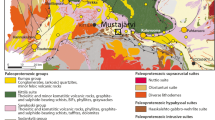Abstract.
The Tapajós region is one domain of a major Paleoproterozoic orogenic belt, named Tapajós–Parima and is discussed in the context of the evolution of the Amazon Craton. The orogenic belt is composed of a back-arc sequence, four volcano-plutonic arcs, intra-arc sedimentation and is limited to the east by the cratonic rocks of the Central Amazon Province. The evolution and timing of the main events is established by zircon, baddeleyite, and titanite SHRIMP U–Pb geochronology of 29 rock samples, while lead and argon isotopes are used to study the age and source of the gold mineralization. Based on the mesoscopic nature of the orebodies, and, in some cases, on microthermometric and stable isotope data, the Tapajós gold deposits are classified as (1) orogenic and (2) intrusion-related, and may be grouped into four deposit-type categories: (1) orogenic, turbidite-hosted: disseminated and quartz–pyrite veinlet deposits, hosted by metaturbidites (lower greenschist-facies, Jacareacanga Group) and emplaced in ductile structures; (2) orogenic, magmatic arc-hosted: disseminated and pyrite–quartz–carbonate vein deposits, hosted by metamorphic rocks (Cuiú-Cuiú Complex) and formed under a ductile–brittle regime, with the Ouro Roxo deposit as a type example; (3) intrusion-related, epizonal quartz-vein deposits: vertical to subvertical quartz-pyrite veins and pyrite disseminations filling extensional brittle faults; and (4) intrusion-related, epizonal, disseminated/stockwork deposits, the type-example being the Serrinha deposit. Gold mineralization of type 3 is similar to that of Korean-type, while type 4 mineralization shows some similarities to porphyry-type deposits. Galena Pb–Pb and muscovite Ar–Ar data indicate an age of ~1,860 Ma for the intrusion-related gold mineralization. Preliminary Pb isotope data on K-feldspar indicate that the fluid source was more likely to have been from within the Jacareacanga, Cuiú-Cuiú and Tropas units than the Creporizão, Maloquinha, and Iriri units. This study shows the existence of two main types (orogenic and intrusion-related) of gold deposits, which are related to specific tectono-magmatic events that occurred during a limited period of time in the orogenic belt evolution. This information may be useful as a guide for gold exploration along the orogenic belt.
Similar content being viewed by others
Author information
Authors and Affiliations
Additional information
Electronic Publication
Rights and permissions
About this article
Cite this article
Santos, J., Groves, D., Hartmann, L. et al. Gold deposits of the Tapajós and Alta Floresta Domains, Tapajós–Parima orogenic belt, Amazon Craton, Brazil. Min Dep 36, 278–299 (2001). https://doi.org/10.1007/s001260100172
Received:
Accepted:
Published:
Issue Date:
DOI: https://doi.org/10.1007/s001260100172




